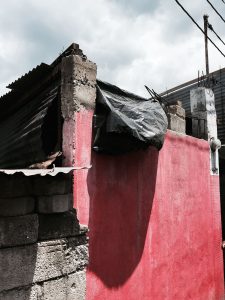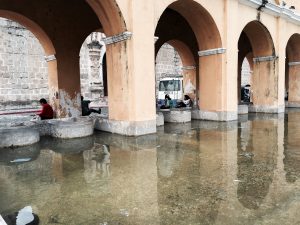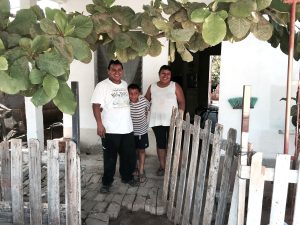
Broken
My feet go free, I turn to look for a handhold, grab for a planter that looks larger than it actually is, extend my right hand backward as my feet fly in front of me. The full weight of my body drives my hand into the unyielding tile and I hear a sickening crunch. A thunderbolt of pain races from the heel of my palm to the tips of my toes as I hit the ground. Sitting up, I see my twisted forearm and instinctively grab it, pressing and twisting it to where I think it needs to go. Friends come to my assistance and want me to stand, but I refuse. I hear someone ask, through the buzz in my head and the rain pounding on the metal roof, if I can get up. I don’t remember answering. I feel hands on my back…faces shimmer in front of me, then fade to black.
In Chocola the previous day, Anne and Wendy from the Wuqu Kawoq NGO recounted the failures in the Guatemalan medical system for Mayan citizens. Mothers refuse pre-natal care so babies don’t get so big they need hospital care to birth them. They’d rather risk themselves and their baby’s health instead of accessing a medical system that lacks a human touch. That sentiment is echoed in San Juan in my conversation with Albino and Alejandro, two Mayan artists who visit the local curandera (healer) for broken bones instead of going to the nearest hospital. The curendara gathers medicinal plants high up the mountain, grinds and mixes them, burns them over a fire and applies the concoction to the fracture site once a day for three days. Alejandro says, in twenty days, healing is complete.
As westerners it’s hard for us to imagine shunning modern medicine for non-traditional methods, but we trust modern medicine in the same way indigenous people trust the curandera whose indigenous healing methods were tested over many centuries. There are massive fractures in the Guatemalan health care system from rural to urban and Latino to Mayan populations. Trust and language differences are major barriers in addition to limited medical facilities. A very small group of wealthy Latinos control the distribution of services to the twenty-odd cultural groups in Guatemala. A tilted playing field results, and poor rural people suffer from inequities, large and small.
Rich Guatemalans are not fully to blame for shattered public systems. The U.S. and its economy share responsibility for some of the problems here. Agricultural exporters sending product to the states demand low prices, growers cut costs by reducing wages, as a result families work for incomes at or below the poverty line. With 40% of the economy based in agriculture, the effect of depressed wages ripples through the Guatemalan economy. Low wages earners are reluctant to pay taxes crushing the government’s ability to provide effective services. High wage earners just refuse to pay. Deteriorating roads and buildings are obvious signs of the underfunded infrastructure, but a nationwide water pollution problem affects national health. A non-existent national water policy and water regulations that vary, state-to-state and town-to-town, lowers the probability that clean water will be delivered to the people.As a result, fifty percent of Guatemalans suffer from intestinal diseases like dysentery and typhoid. Numbers like that have broken the medical infrastructure in two. One system of private clinics and modern hospitals serve those who can pay, and another system of crumbling, overwhelmed, public hospitals with low-tech equipment serves those who can’t.
Even though I am transported in a fire department ambulance, my destination is a private clinic in Mazatenanga where I will be seen without delay. The building is old and the X-ray machine is 1960s vintage. Fortunately for me, I can pay. For the ambulance ride, examination, X-ray film, partial cast and pain medication, I’m out about $225. That is about 1,500 Quetzales or a month’s wages for a farm worker here. To get the operation to repair a multiple displaced fracture like mine could bankrupt that same farmer due to cost, lack of insurance and wages lost while recuperating. That farmer might wait at the emergency room 24 to 48 hours for treatment not including the travel time to get to one of the few hospitals. In three hours I’m patched up and out the door. However, like the average local, I’ll refuse surgery due to a lack of trust in the system, but unlike the locals, I will not lack funds. When I arrive home in four days I’ll engage the differently dysfunctional U.S. medical system, and pay nearly two hundred times what equivalent services cost in Guatemala. The process might be frustrating and the cost high, but I probably will survive and not go bankrupt.
My wrist fracture will be repaired, and I will get full function from my arm in short order. Guatemalans however, are stuck with a medical system that may never overcome its brokenness. Even under these conditions, the Guatemalan people are welcoming, friendly and happy. The systems of support may be broken, but the people are not.




